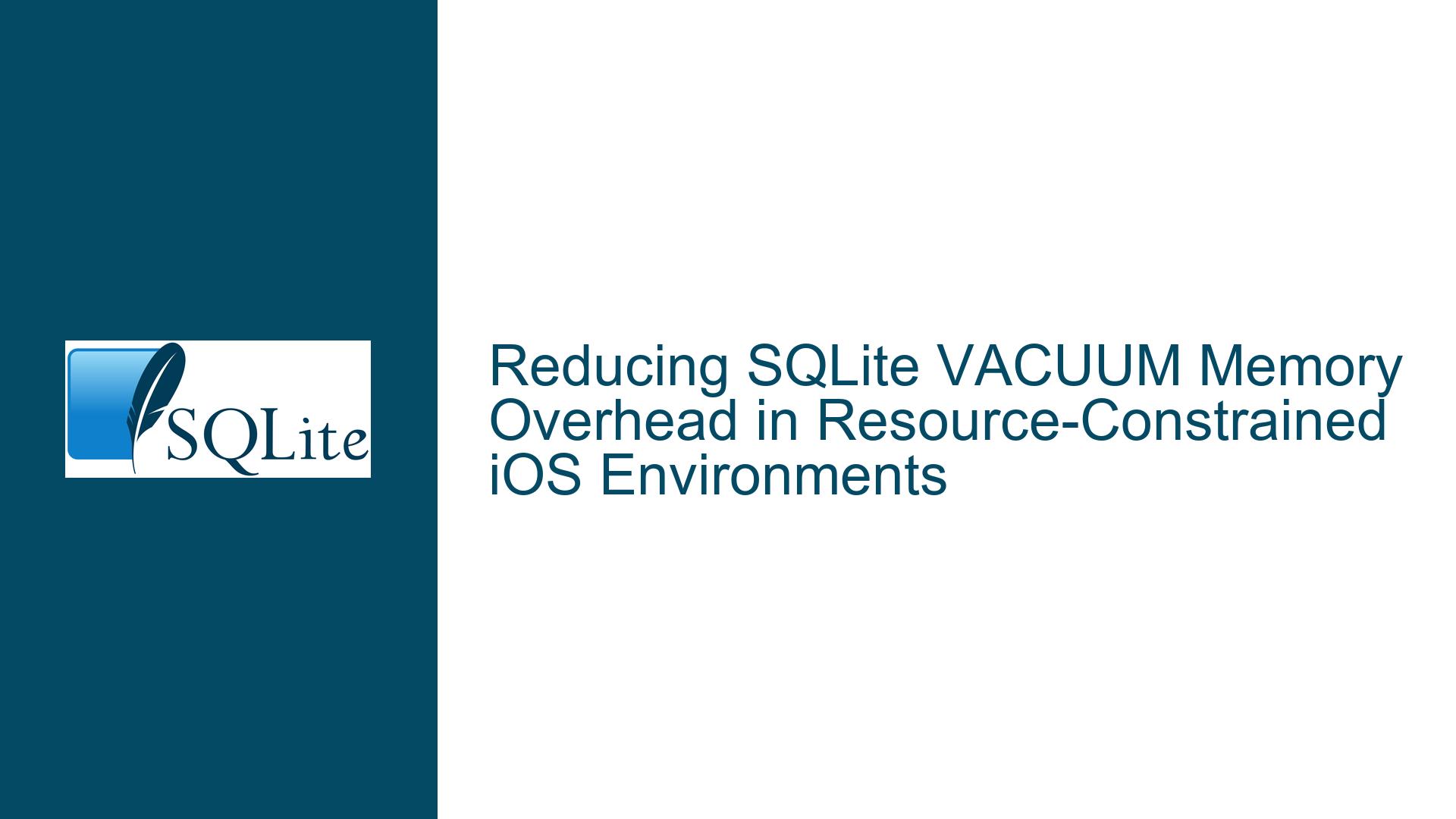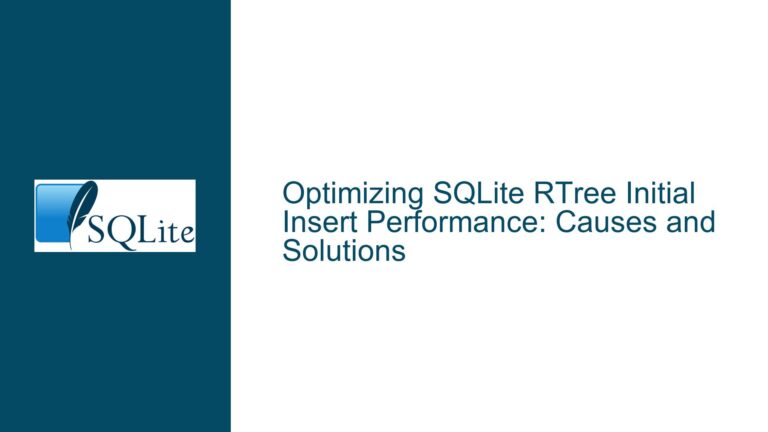Reducing SQLite VACUUM Memory Overhead in Resource-Constrained iOS Environments
Understanding High Memory Consumption During SQLite VACUUM Operations on iOS
The core challenge revolves around SQLite’s VACUUM command consuming excessive memory (over 1GB) on iOS devices, leading to application termination by the operating system due to resource constraints. This issue arises in environments where SQLite is integrated with encryption layers like SQLCipher and virtual file systems such as IOCipher/libsqlfs. The database size (~1GB) exacerbates the problem, as VACUUM requires substantial temporary resources to rebuild the database, remove free pages, and optimize storage. The operation is critical for reducing file size during cloud backups, but the memory spikes during execution make it impractical for iOS applications, particularly when running in the background.
Key technical factors include SQLite’s default behavior of prioritizing memory over disk for temporary objects, the absence of granular memory throttling during intensive operations, and the interaction between SQLCipher’s encryption overhead and iOS’s strict memory management. The user’s experimentation with PRAGMA hard_heap_limit and PRAGMA soft_heap_limit highlights the limitations of SQLite’s memory-limiting mechanisms when applied to operations like VACUUM, which inherently require large working sets.
Root Causes of Excessive Memory Allocation in SQLite VACUUM
Temporary Storage Configuration (temp_store):
SQLite’sVACUUMoperation creates a temporary in-memory database to rebuild the main database. By default, SQLite uses thetemp_storepragma setting defined at compile time, which is often set toDEFAULT(0), allowing it to use memory for temporary objects. On systems whereSQLITE_TEMP_STOREis not explicitly configured to favor disk, this results in unbounded memory consumption proportional to the database size.Page Cache and Spill Behavior (cache_size, cache_spill):
The page cache size (PRAGMA cache_size) determines how many database pages SQLite retains in memory. Larger caches improve performance but increase memory footprint. DuringVACUUM, the cache may grow to accommodate the temporary database, especially ifcache_spillis not configured to enforce earlier spilling of pages to disk.VACUUM’s Two-Pass Execution:
TheVACUUMcommand operates by (1) copying live data to a temporary database and (2) rebuilding the original database from the temporary copy. This dual-phase process requires simultaneous storage for both the original and temporary databases, doubling the memory or disk space required during execution.Encryption Overhead with SQLCipher:
When SQLCipher is enabled, all database pages (including temporary ones) are encrypted and decrypted on-the-fly. This adds computational overhead that can indirectly increase memory pressure, as intermediate data structures may remain in memory longer to avoid repeated encryption/decryption cycles.iOS Storage Quotas and Background Limitations:
iOS imposes strict limits on background process memory usage and restricts access to certain directories for temporary files. If SQLite’s temporary files are stored in memory or in a restricted directory, the system may terminate the application due to perceived resource abuse.
Mitigating Memory Pressure During VACUUM: Configurations and Workarounds
1. Forcing Temporary Storage to Disk via temp_store
SQLite’s temp_store pragma directs where temporary objects (e.g., indices, tables) are stored. Setting temp_store=2 forces all temporaries to use disk-backed storage:
PRAGMA temp_store = 2; -- Use files, not memory, for temporary objects
Implementation Notes:
- Verify that the iOS application has write access to the directory specified by
SQLITE_TMPDIRor the default temporary directory. - Monitor disk space, as the temporary database will consume ~1GB of storage during
VACUUM. - Combine with
PRAGMA temp_store_directory(deprecated in newer versions) or environment variables to control the temporary file location.
2. Reducing Page Cache Size and Enabling Cache Spill
Lower the page cache size and configure cache_spill to force earlier spilling of pages to disk:
PRAGMA cache_size = -1000; -- Limit cache to ~1MB (assuming 1KB page size)
PRAGMA cache_spill = 1; -- Allow spilling to disk even before cache is full
Trade-offs:
- Smaller caches reduce memory usage but increase I/O operations, potentially slowing down
VACUUM. - Test different
cache_sizevalues (e.g.,-2000for 2MB) to balance memory and performance.
3. Using VACUUM INTO for Incremental Storage Optimization
The VACUUM INTO command writes the optimized database directly to a new file, bypassing the need for a temporary in-memory copy:
VACUUM INTO '/path/to/optimized.db';
Procedure:
- Execute
VACUUM INTOto create a new optimized database file. - Replace the original database with the new file after successful completion.
- Delete the original database only after verifying the integrity of the new file.
Advantages: - Avoids simultaneous storage of temporary and original databases in memory.
- Allows incremental progress checks and better memory control.
4. Adjusting Database Page Size and Sector Alignment
A larger page size reduces the number of pages SQLite must manage, indirectly lowering memory overhead:
PRAGMA page_size = 8192; -- Set page size to 8KB (requires database recreation)
Caveats:
- Changing
page_sizerequires a fullVACUUMto take effect, creating a circular dependency. - Optimal page size depends on the data access patterns; larger pages benefit sequential scans, smaller pages favor random access.
5. Leveraging Incremental VACUUM with Auto-Vacuum
Enable incremental vacuuming to avoid full VACUUM operations:
PRAGMA auto_vacuum = INCREMENTAL;
PRAGMA incremental_vacuum;
Limitations:
- Incremental vacuuming only reclaims free pages from the freelist and does not defragment the database.
- Requires
auto_vacuumto be set before the database is populated with data.
6. Combining VACUUM with Backup API for Cloud Uploads
Use SQLite’s Backup API to create compressed backups without requiring a full VACUUM:
// Example using SQLite C API
sqlite3_backup_init(dest_db, "main", source_db, "main");
sqlite3_backup_step(dest_db, -1);
sqlite3_backup_finish(dest_db);
Benefits:
- Backup API streams data directly, reducing transient memory spikes.
- Integrates with cloud uploads to avoid local storage bottlenecks.
7. Monitoring and Tuning iOS-Specific Storage Quotas
- Ensure temporary files are written to a directory with sufficient space, such as
NSTemporaryDirectory(). - Use
sqlite3_config(SQLITE_CONFIG_URI, 1)to enforce URI filenames, enabling parameters likecache=sharedfor multi-threaded memory management.
8. Profiling Memory Usage with SQLite Internals
Activate SQLite’s memory profiling to identify leaks or excessive allocations:
PRAGMA memory_status;
SELECT * FROM sqlite_meminfo();
Analysis Steps:
- Compare memory usage before, during, and after
VACUUM. - Identify components (e.g., page cache, schema parsing) consuming disproportionate memory.
Final Recommendations
For iOS applications using SQLCipher and libsqlfs, prioritize VACUUM INTO combined with temp_store=2 and reduced cache_size. Test configurations on target devices to empirically determine the optimal balance between memory usage and execution time. If VACUUM remains prohibitive, consider replacing it with incremental vacuuming or offloading database optimization to a server-side process where resource constraints are less severe.






